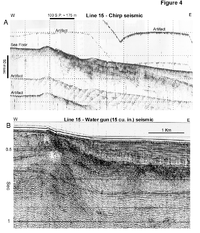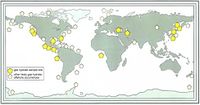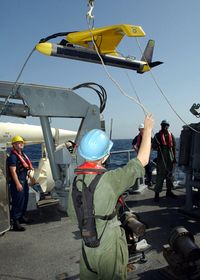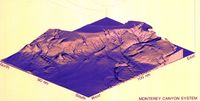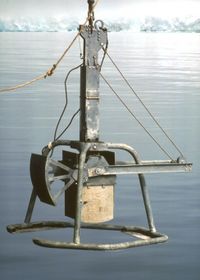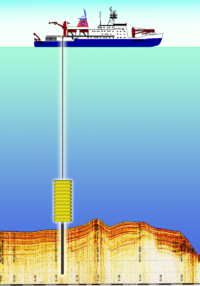الهندسة الجيوتقنية البحرية
الهندسة الجيوتقنية البحرية Offshore geotechnical engineering، هي تخصص فرعي في الهندسة الجيوتقنية. وتعنى بالتصميم الأساسي، الانشاءات، الصيانة ووقف تشغيل المنشآت من صنع الإنسان في البحر.[1] من أمثلة تلك المنشآت منصات النفط، الجزر الاصطناعية وخطوط الأنابيب تحت الماء. قاع البحر يجب أن يكون قادراً على تحمل وزن مثل هذه المنشآت والحمولات المطبقة. ويجب أيضاً الأخذ في الحسبان بالمخاطر الأرضية. نشأت الحاجة للتطويرات البحرية من النضوب التدريجي لاحتياطيات الكربون الموجودة على البر أو بالقرب من السواحل، مثل الحقول الجديدة التي تم تطويرها على مسافات بحرية أبعد وداخل المياه العميقة،[2] مع التكيف المقابل للاستقصاءات الميدانية البحرية.[3] اليوم، هناك أكثر من 7.000 منصة بحرية يتم تشغيلها في أعماق تصل إلى وتتجاوز 2000 م.[2] تطوير الحق التقليدي يتجاوز عشرات الكيلومترات المربعة، وقد يضم العديد من المنشآت المثبتة، خطوط التدفق داخل الحقل وخطوط أنابيب تصدير سواء للشاطئ أو للتوصيل بخط التحويل الاقليمي.[4]
. . . . . . . . . . . . . . . . . . . . . . . . . . . . . . . . . . . . . . . . . . . . . . . . . . . . . . . . . . . . . . . . . . . . . . . . . . . . . . . . . . . . . . . . . . . . . . . . . . . . . . . . . . . . . . . . . . . . . . . . . . . . . . . . . . . . . . . . . . . . . . . . . . . . . . . . . . . . . . . . . . . . . . . .
الفروق بين الهندسة التقنية البرية والبحرية
البيئة البحرية
طبيعة التربة
الجوانب المتيوسينية
المخاطر الأرضية
الاستقصاءات الميدانية
الدراسات المكتبية
المسوحات الجيوفيزيائية
المسوحات الجيوتقنية
جمع العينات والحفر
. . . . . . . . . . . . . . . . . . . . . . . . . . . . . . . . . . . . . . . . . . . . . . . . . . . . . . . . . . . . . . . . . . . . . . . . . . . . . . . . . . . . . . . . . . . . . . . . . . . . . . . . . . . . . . . . . . . . . . . . . . . . . . . . . . . . . . . . . . . . . . . . . . . . . . . . . . . . . . . . . . . . . . . .
اختبار التربة
المنشآت البحرية والاعتبارات الجيوتقنية
خطوط الأنابيب تحت الماء
انظر أيضاً
الهوامش
المصادر
المراجع
- Bai Y. and Bai Q. (2010) Subsea Engineering Handbook. Gulf Professional Publishing, New York, 919 pp.
- Bransby M.F., Yun G.J. Morrow D.R. and Brunning P. (2005) The performance of pipeline ploughs in layered soils. In: S.C.M. Gourvenec (Editor), Frontiers in Offshore Geotechnics, Taylor & Francis, Perth, Australia, pp. 597–605.
- Cathie D.N., Jaeck C., Ballard J.-C. and Wintgens J.-F. (2005) Pipeline geotechnics – state-of-the-art. In: S.C.M. Gourvenec (Editor), Frontiers in Offshore Geotechnics. Taylor & Francis, Perth, Australia, pp. 95–114.
- Das B.M. (2010) Principles of geotechnical engineering, Cengage Learning, Stamfort, U.S.A., 666 p.
- Dean E.T.R. (2010) Offshore Geotechnical Engineering - Principles and Practice, Thomas Telford, Reston, VA, U.S.A., 520 p.
- Gerwick B.C., (2000) Construction of marine and offshore structures, CRC Press, Boca Raton, U.S.A., 657 p.
- Hogan P., Lane A., Hooper J., Broughton A. and Romans B. (2008) Geohazard challenges of the Woodside OceanWay Secure Energy LNG development, offshore Southern California, Proceedings of the 40th Offshore Technology Conference (OTC), Paper OTC19563, Houston.
- Kolk H.J. and Wegerif J. (2005) Offshore site investigations: new frontiers. In: S.C.M. Gourvenec (Editor), Frontiers in Offshore Geotechnics, Taylor & Francis, Perth, Australia, pp. 145–161.
- Newson T.A., Bransby M.F., Brunning P. and Morrow D.R. (2004) Determination of undrained shear strength parameters for buried pipeline stability in deltaic soft clays, Proceedings of the 14th International Offshore and Polar Engineering Conference, The International Society of Offshore and Polar Engineers (ISOPE), Toulon, pp. 38–48.
- Palmer A.C. and Been K. (2011) Pipeline geohazards for Arctic conditions. In: W.O. McCarron (Editor), Deepwater Foundations and Pipeline Geomechanics, J. Ross Publishing, Fort Lauderdale, Florida, pp. 171–188.
- Peuchen L.J. and Raap C., (2007) Logging, sampling and testing for offshore geohazards, Proceedings of the 39th Offshore Technology Conference (OTC), Paper 18664, Houston.
- Ramakrishnan T.V. (2008). Offshore Engineering, Gene-Tech Books, New Delhi, India, 347 p.
- Randolph M. and Gourvenec S. (2011) Offshore geotechnical engineering, Spon Press, N.Y., 550 p.
- Younes A.I., Gibson J.L. and Shipp R.C. (2005) Geohazard assessment of the deepwater Princess field in the Northeastern Gulf of Mexico: Example of evaluating complex faulting in a subsea development, Proceedings of the 37th Offshore Technology Conference (OTC), Paper 17577, Houston.
- Zhang J. and Erbrich C.T. (2005) Stability design of untrenched pipelines – geotechnical aspects. In: S.C.M. Gourvenec (Editor), Frontiers in Offshore Geotechnics, Taylor & Francis, Perth, Australia, pp. 623–628.

